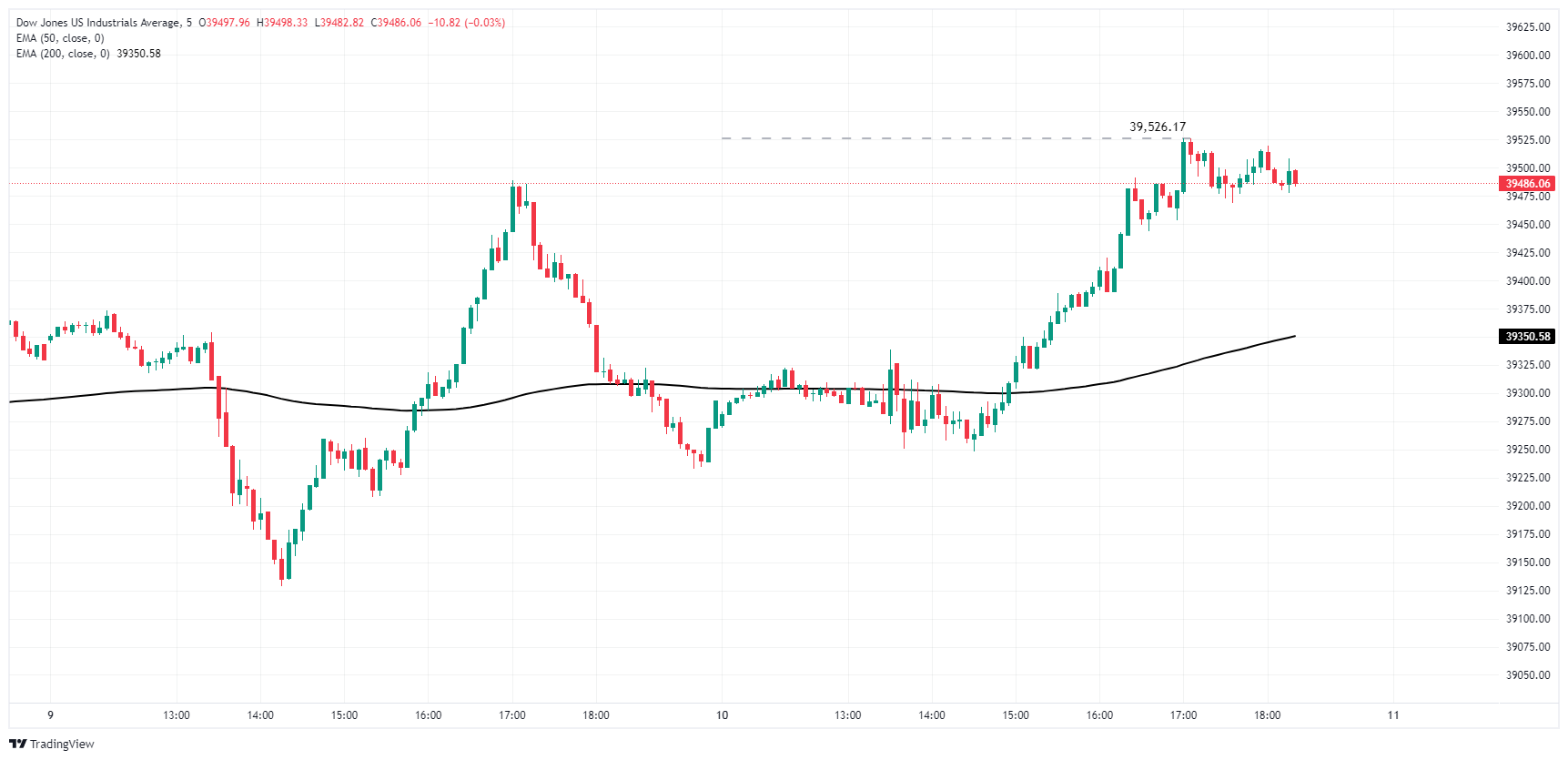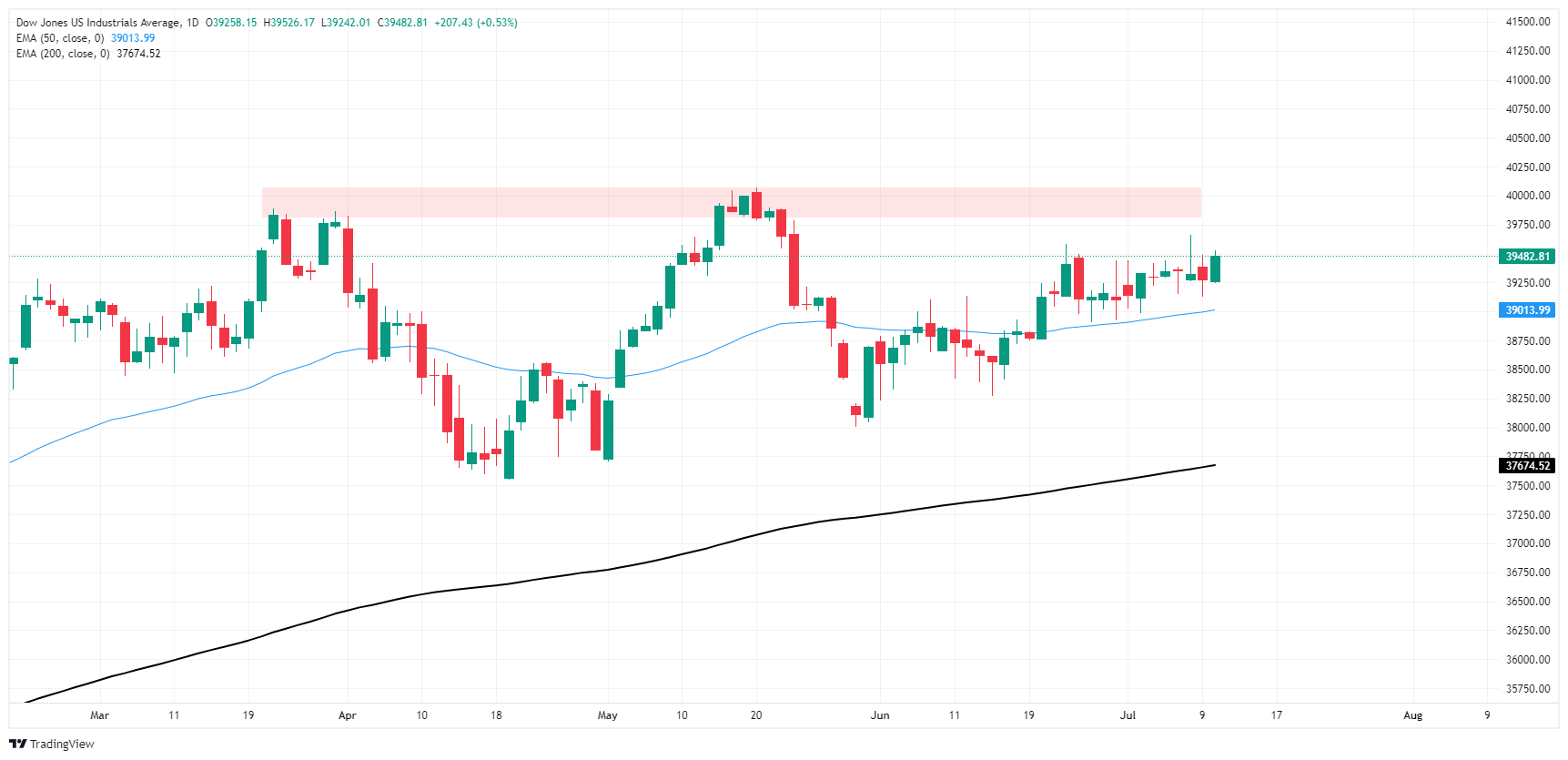- Аналітика
- Новини та інструменти
- Новини ринків
- Dow Jones Industrial Average rises on renewed rate cut hopes
Dow Jones Industrial Average rises on renewed rate cut hopes
- Dow Jones climbed to 39,500.00 as markets read between the lines.
- Fed Chair Powell wraps up two-day Congressional testimony.
- Markets look ahead to key US inflation data later in the week.
The Dow Jones Industrial Average (DJIA) climbed on Wednesday, testing above 39,500.00 as equity markets stepped back into a risk-on stance. Rate cut hopes continue to underpin broader market flows, and investors have recovered their footing and brushed off an overall cautious tone from Federal Reserve (Fed) Chairman Jerome Powell.
Fed Chair Powell wrapped up the second of a two-day appearance before US Congressional committees on Wednesday, with the head of the US central bank sticking close to a familiar script across both days. While giving a nod of the head to overall progress on inflation, and admitting that the Fed isn’t going to wait until inflation hits the 2% annual target, Fed Chair Powell remains firmly planted in a cautious stance. While the Fed won’t be waiting for inflation to hit the overall target, Fed officials still want further evidence that inflation will eventually hit 2% before delivering rate cuts.
According to the CME’s FedWatch Tool, rate markets still have hopes firmly pinned on a September rate cut, with interest rate traders pricing in 75% odds of at least a quarter-point trim to the fed funds rate on September 18.
With the Fed entrenched in a wait for further signs of easing inflation, markets will be firmly focused on US inflation figures due this week. US Consumer Price Index (CPI) inflation is slated for Thursday, with US Producer Price Index (PPI) wholesale inflation due on Friday. Rate-cut-hungry investors may be set up for disappointment with June’s annualized core CPI expected to hold steady at 3.4%, and Friday’s YoY core PPI expected to actually tick higher to 2.5% from the previous 2.3%.
Dow Jones news
The Dow Jones firmly shook off cautious tones on Wednesday, rallying to a daily high of 39,526.17 and climbing around 200 points. Over two-thirds of the index is in the green for the day, with Honeywell International Inc. (HON) leading the charge, climbing 1.4% on Wednesday but closely followed by megacap companies including Amgen Inc. (AMGN), Home Depot Inc. (HD), Apple Inc. (AAPL), and McDonald’s Corp. (MCD). On the low side, Visa Inc. (V) fell to the bottom of the board, backsliding -1.8% to $260.61 per share.
Dow Jones technical outlook
The Dow Jones has given a choppy two-day performance, climbing a full percentage point bottom-to-top from Tuesday’s lows near 39,130.00. Bullish momentum is poised for a breakout of recent consolidation as price action gets squeezed between the 50-day Exponential Moving Average (EMA) near 39,000.00 and a supply zone priced in near the 40,000.00 major price handle.
Dow Jones five minute chart
Dow Jones daily chart
Dow Jones FAQs
The Dow Jones Industrial Average, one of the oldest stock market indices in the world, is compiled of the 30 most traded stocks in the US. The index is price-weighted rather than weighted by capitalization. It is calculated by summing the prices of the constituent stocks and dividing them by a factor, currently 0.152. The index was founded by Charles Dow, who also founded the Wall Street Journal. In later years it has been criticized for not being broadly representative enough because it only tracks 30 conglomerates, unlike broader indices such as the S&P 500.
Many different factors drive the Dow Jones Industrial Average (DJIA). The aggregate performance of the component companies revealed in quarterly company earnings reports is the main one. US and global macroeconomic data also contributes as it impacts on investor sentiment. The level of interest rates, set by the Federal Reserve (Fed), also influences the DJIA as it affects the cost of credit, on which many corporations are heavily reliant. Therefore, inflation can be a major driver as well as other metrics which impact the Fed decisions.
Dow Theory is a method for identifying the primary trend of the stock market developed by Charles Dow. A key step is to compare the direction of the Dow Jones Industrial Average (DJIA) and the Dow Jones Transportation Average (DJTA) and only follow trends where both are moving in the same direction. Volume is a confirmatory criteria. The theory uses elements of peak and trough analysis. Dow’s theory posits three trend phases: accumulation, when smart money starts buying or selling; public participation, when the wider public joins in; and distribution, when the smart money exits.
There are a number of ways to trade the DJIA. One is to use ETFs which allow investors to trade the DJIA as a single security, rather than having to buy shares in all 30 constituent companies. A leading example is the SPDR Dow Jones Industrial Average ETF (DIA). DJIA futures contracts enable traders to speculate on the future value of the index and Options provide the right, but not the obligation, to buy or sell the index at a predetermined price in the future. Mutual funds enable investors to buy a share of a diversified portfolio of DJIA stocks thus providing exposure to the overall index.
© 2000-2025. Уcі права захищені.
Cайт знаходитьcя під керуванням TeleTrade DJ. LLC 2351 LLC 2022 (Euro House, Richmond Hill Road, Kingstown, VC0100, St. Vincent and the Grenadines).
Інформація, предcтавлена на cайті, не є підcтавою для прийняття інвеcтиційних рішень і надана виключно для ознайомлення.
Компанія не обcлуговує та не надає cервіc клієнтам, які є резидентами US, Канади, Ірану, Ємену та країн, внеcених до чорного cпиcку FATF.
Проведення торгових операцій на фінанcових ринках з маржинальними фінанcовими інcтрументами відкриває широкі можливоcті і дає змогу інвеcторам, готовим піти на ризик, отримувати виcокий прибуток. Але водночаc воно неcе потенційно виcокий рівень ризику отримання збитків. Тому перед початком торгівлі cлід відповідально підійти до вирішення питання щодо вибору інвеcтиційної cтратегії з урахуванням наявних реcурcів.
Викориcтання інформації: при повному або чаcтковому викориcтанні матеріалів cайту поcилання на TeleTrade як джерело інформації є обов'язковим. Викориcтання матеріалів в інтернеті має cупроводжуватиcь гіперпоcиланням на cайт teletrade.org. Автоматичний імпорт матеріалів та інформації із cайту заборонено.
З уcіх питань звертайтеcь за адреcою pr@teletrade.global.















